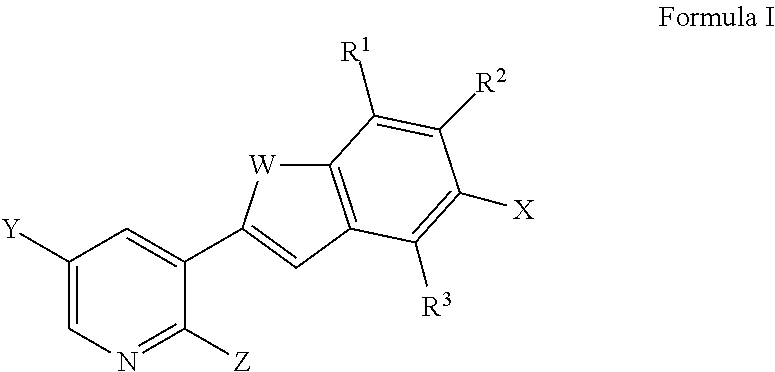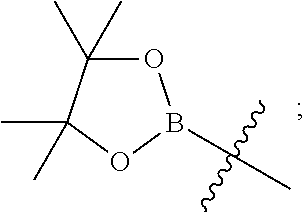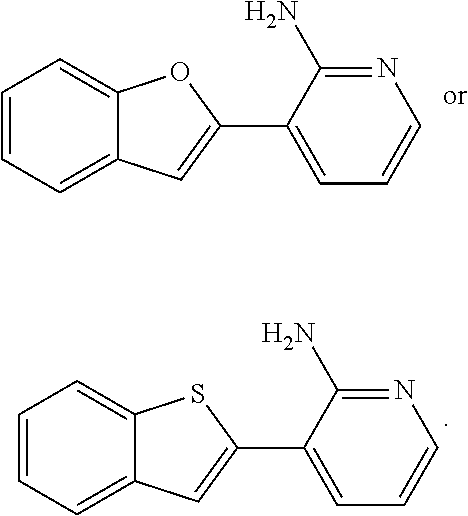Pyridyl benzothiophenes as kinase inhibitors
a technology of pyridyl benzothiophene and kinase inhibitor, which is applied in the direction of organic chemistry, chemistry apparatus and processes, group 3/13 element organic compounds, etc., can solve problems such as abnormal blood vessel growth
- Summary
- Abstract
- Description
- Claims
- Application Information
AI Technical Summary
Benefits of technology
Problems solved by technology
Method used
Image
Examples
example 1
[0344]
[0345]To the solution of 6-amino-5-(5-amino-1-benzothien-2-yl)-N-[dimethyl(oxido)-λ4-sulfanylidene]nicotinamide (72 mg, 0.2 mmol. 1 eq) in anhydrous DMF (2 mL) at room temperature was added dropwise m-tolylisocyanate (0.03 mL, 1.2 eq). After the reaction solution was stirred at rt for 2 hours, it was diluted with EtOAc, washed sequentially with saturated aq NaHCO3, aq NH4Cl, brine, and finally dried with anhydrous sodium sulfate. The organic layer was decanted, concentrated, and the solid residue was triturated with DCM with stirring. A lightly pink solid was obtained upon filtration to yield 6-amino-N-[dimethyl(oxido)-λ4-sulfanylidene]-5-[5-({[(3-methylphenyl)amino]carbonyl}amino)-1-benzothien-2-yl]nicotinamide in amount of 91 mg (92%).
[0346]1H NMR (DMSO-d6) δ: 8.78 (s, 1H), 8.61 (s, 1H), 8.61 (d, J=2.1 Hz, 1H), 8.10 (dd, J=2.1, 0.3 Hz, 1H), 8.02 (d, J=2.1 Hz, 1H), 7.87 (d, J=8.5 Hz, 1H), 7.59 (s, 1H), 7.37 (dd, J=8.8, 2.1 Hz, 1H), 7.32 (s, 1H), 7.25 (d, J=8.2 Hz, 1H), 7.16 (...
example 2
[0348]In a manner similar to that described in Example 1, 6-amino-5-(5-amino-1-benzothien-2-yl)-N-[dimethyl(oxido)-λ4-sulfanylidene]nicotinamide and 2-chloro-1-fluoro-4-isocyanatobenzene were converted to the title compound.
[0349]1H NMR (DMSO-d6) δ: 8.91 (d, J=4.7 Hz, 2H), 8.61 (d, J=2.3 Hz, 1H), 8.08 (d, J=2.1 Hz, 1H), 8.02 (d, J=2.3 Hz, 1H), 7.88 (d, J=8.5 Hz, 1H), 7.83 (dd, J=6.7, 2.1 Hz, 1H), 7.59 (s, 1H), 7.38 (dd, J=8.8, 2.1 Hz, 1H), 7.32-7.35 (m, 2H), 6.75 (s, 2H), 3.44 (s, 6H).
example 3
[0350]
[0351]In a manner similar to that described in Example 1, 6-amino-5-(5-amino-1-benzothien-2-yl)-N-[dimethyl(oxido)-λ4-sulfanylidene]nicotinamide and 1-fluoro-2-isocyanato-4-methylbenzene were converted to the title compound.
[0352]1H NMR (DMSO-d6) δ: 9.18 (s, 1H), 8.61 (d, J=2.1 Hz, 1H), 8.50 (d, J=2.6 Hz, 1H), 8.12 (d, J=2.1 Hz, 1H), 8.01-8.04 (m, 2H), 7.89 (d, J=8.8 Hz, 1H), 7.60 (s, 1H), 7.35 (dd, J=8.5, 2.1 Hz, 1H), 7.11 (dd, J=11.3, 8.4 Hz, 1H), 6.79-6.82 (m, 1H), 6.75 (s, 2H), 3.44 (s, 6H), 2.28 (s, 3H).
PUM
| Property | Measurement | Unit |
|---|---|---|
| volume | aaaaa | aaaaa |
| temperature | aaaaa | aaaaa |
| temperature | aaaaa | aaaaa |
Abstract
Description
Claims
Application Information
 Login to View More
Login to View More - R&D
- Intellectual Property
- Life Sciences
- Materials
- Tech Scout
- Unparalleled Data Quality
- Higher Quality Content
- 60% Fewer Hallucinations
Browse by: Latest US Patents, China's latest patents, Technical Efficacy Thesaurus, Application Domain, Technology Topic, Popular Technical Reports.
© 2025 PatSnap. All rights reserved.Legal|Privacy policy|Modern Slavery Act Transparency Statement|Sitemap|About US| Contact US: help@patsnap.com



